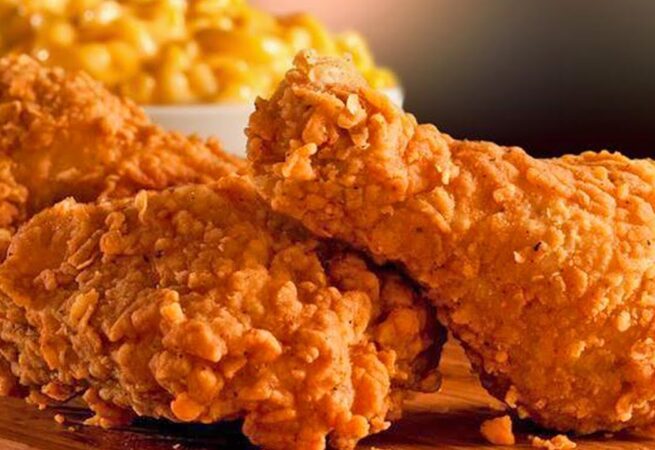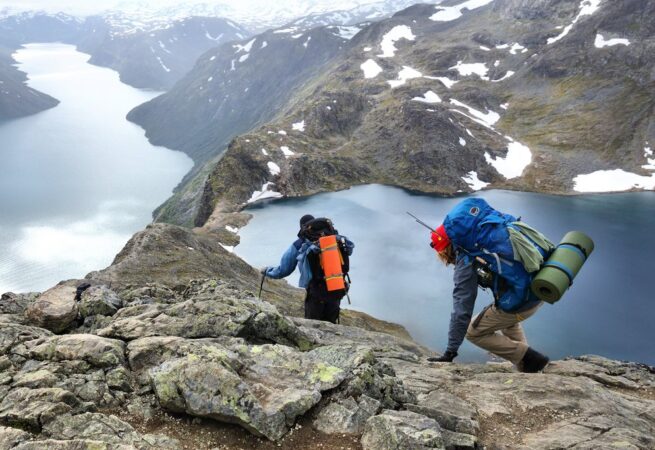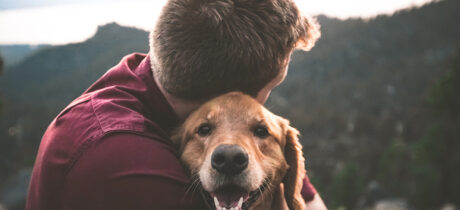
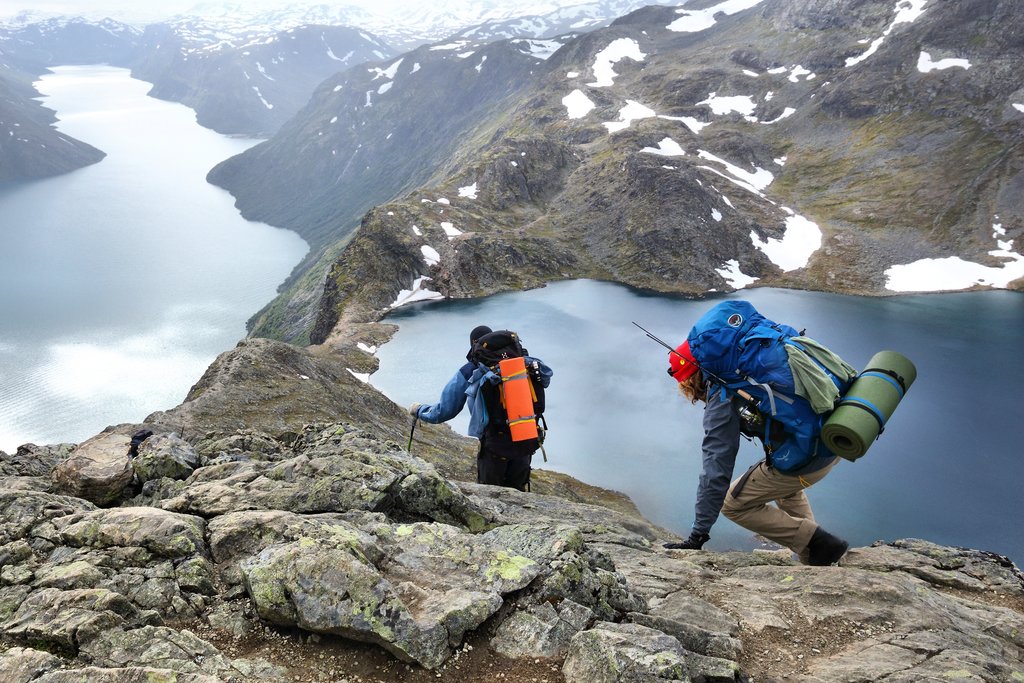
Iconic hikes in the Norwegian Fjords
Most people’s experience of the Norwegian fjords is from the deck of a cruise ship, but it’s more rewarding to set out on foot and explore. Of course, the geography dictates that the walks involve big ups and downs, starting and finishing at the fjord edge. It’s exhilarating and not for the fainthearted.
Stavanger
I fly into Stavanger and pick up my car. It’s a pretty port, tall-masted sailing boats moored in the harbour and rows of 18th century white wooden houses rising from the water’s edge. Normally it’s full of cruise ships, but the pandemic has put a stop to that.
This is Norway’s Oil City, the North Sea oilfields not far away, and the revenue supports several high-end restaurants. You can eat well here, as I find out during my three nights stay.
Preikestolen (The Pulpit Rock) 4 hours return
Norway has some long road tunnels, and my first day leads me through two, the longest over 13km. I’m heading east to Lysefjord, 42km long and one of the most beautiful. The target here is Preikestolen or Pulpit rock, high above the fjord, and it’s a popular climb with people of all ages. Still, it starts off steeply, then crosses boggy sections before levelling out at around 600m.
From this point, it’s an easy walk across white granite slabs with stunning views of the fjord below. Soon the rock itself comes into sight as you negotiate a narrow path along the cliffs. It juts out into the air, high above the water, and there are no fences or guard rails. Brave souls go right to the edge performing vertigo-inducing acrobatics for the cameras. I’m content just to take their pictures before descending and returning to Stavanger.
Trollpikken 2 hours return
Today I drive south following the coast, mist still clinging to the shore, past tiny fishing villages and solitary lighthouses. In the past, this was known as the most dangerous coastline in Norway, but today it’s a pleasant scenic drive.
After an hour, I reach the attractive port of Egersund and turn inland. A narrow road leads to a small parking area, and I set off on foot into rolling hills.
There are no fjords today, just patches of water populating the boggy landscape. It’s an easy uphill climb and, just after a small lake, I come face to face with Trollpikken, a huge upright rocky protrusion named after the intimate anatomy of a Troll. Vandals in the 1990s planted explosives at its base with disastrous effect, but it’s since been re-erected. Two young girls scramble up its sides for a photo-call, and I’m happy to oblige.
Langfoss Waterfall 4 hours
I leave my base in Stavanger and head north through tunnels and even a ferry before arriving at Åkrafjorden. Cruise passengers take day trips here to see the Langfoss Waterfall; it’s a 612m drop making it one of Norway’sfinest.
The summer has been dry, so there’s not a huge volume of water, but it’s still spectacular, dropping directly into the fjord. It regularly makes the list of the world’s ten best waterfalls.
I set off steeply on foot, climbing an old mountain path linking the fjord to a farm on the plateau above the waterfall. It leads up through the pine forest, and I stop to catch my breath just above the treeline.
Below, Åkrafjord is laid out on the valley floor and high above, and I can just make out the Folgefonna Glacier. At the top, hearing I’m English, a fisherman tells me that the RAF dropped copious supplies to the resistance, hiding here during WW2. He’s always on the lookout for any remaining but has been disappointed so far.
Rullestad Glacial Potholes 4 hours
I spend the night at Åkrafjord, and the next day the owner of my lodgings is keen to show me one of the natural wonders of the area. To reach the Rullestad Glacial Potholes, it’s another steep climb, followed by the ascent of a sheer rock face, aided by metal rungs and chains. Fortunately, it’s dry, as this definitely should not be tackled in the wet.
Built into the rock face are the potholes, deep holes ground into the rock by water, ice and stones, during the last ice age. They occur as single, and doubles and most are partially filled with mud and water. Without a certain amount of physical fitness, they’d be impossible to get to. The guide tells me that they’re in the process of applying for UNESCO world heritage listing.
Trolltunga 8 hours
Driving further north, I arrive at the industrial town of Odda, at the top of Hardangerfjord, the second-longest fjord in Norway. It makes a good base for exploring Folgefonna National Park and climbing to Trolltunga, the Troll’s Tongue. This is one of Norway’s most well-known hikes, partly because of its length, as you have to allow 8-12 hours for the return trip. At dawn, fellow hikers are already gathering in the car park, ready to make the most of the daylight.
It’s drizzling sporadically, and I climb on a broad wide track, past small lakes and waterfalls. The mist lifts now and then to reveal Lake Ringedalsvatnet below. I’m not alone, but it’s not crowded, and everyone has the same goal.
The Troll’s Tongue is a massive slab of rock jutting out from a cliff 700m above the lake, and I reach it in around 4 hours. The changing visibility makes it even more impressive, and I’m persuaded to walk to the edge for a photo.
Bergen
From Odda, I drive North West to Bergen, with a stop to sample the apple juice at Spildegarden. Hardangerfjord has a microclimate which makes it perfect for fruit trees, and there’s been an excellent harvest this year. Just outside the town is Steinsdalsfossen, another spectacular waterfall you can walk underneath, but there’s no time to linger.
In Bergen, I feel I’ve reached the big city, but the location is attractive, and there’s still some hiking to be done. So I cheat by taking Fløibanen funicular to the top of Mt Fløyen at 320m and enjoy the spectacular view. Well-marked hiking trails lead into the forest and the hills beyond, but I’ll have to save those for another day.
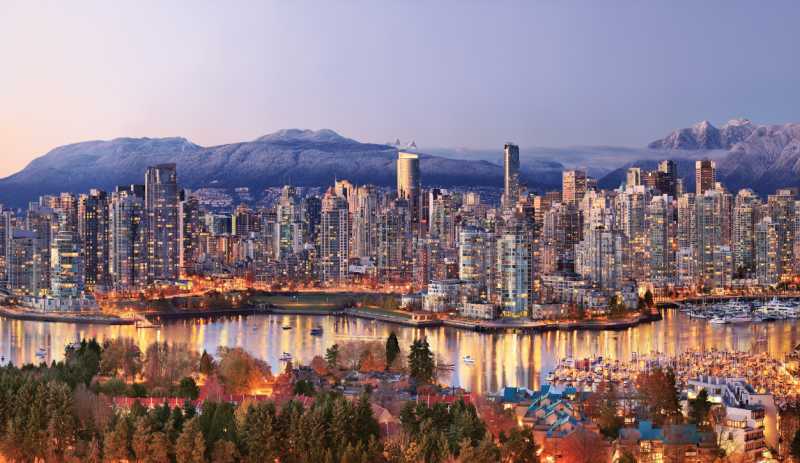
24 hours in Vancouver, Canada
Vancouver is a vibrant west coast Canadian city, dominated by glimmering high rise buildings and surrounded by mighty mountains. It’s home to the legendary Vancouver Canucks hockey team, is a top location choice for the film industry and was the host for the 2010 Winter Olympics. In spring, the streets are lined with cherry blossom trees and in the summer residents flock to the beaches. The city is transformed into a canvas of colour in the autumn as the leaves change, and during the winter the mountainous backdrop is covered in snow. Vancouver is a year-round destination with a bustling downtown centre for city slickers but with an abundance of nature on its doorstep for adventure seekers.
Must see
Stanley Park is a beautiful, public outdoor space with a seawall path for locals and tourists to admire the view by walking, running or cycling. The beaches dotted along the seawall are packed in the summer months with people sunbathing and playing volleyball. In the winter, the views across to North Vancouver and the Coastal Mountains are stunning. There are also many trails crisscrossing the park which contains countless gardens, First Nations totem poles and the Vancouver Aquarium. Entrance to the park is free and available for everyone to enjoy.
Must visit
Gastown is Vancouver’s heritage centre. The downtown area is known as the city’s birthplace and is named after British seaman ‘Gassy’ Jack Deighton who opened Vancouver’s first pub in 1867. Take a stroll around the streets to appreciate the history and architecture, pop into one of the districts many eateries and check out Kit and Ace for some local luxury clothing.
The two-ton Gastown Steam Clock on Water Street is powered by an underground steam pipes system provides heat to most of the downtown core. This must see one of a handful of such clocks in operation around the world. The steam provides the clocks whistles and steam shooting every quarter of an hour.
Must explore
Granville Island is not exactly an island, but is a creative hub at the base of Granville Bridge. The easiest and quickest way to get there is with the Aquabus from False Creek which takes about five minutes. Granville Island is a foodie paradise with a huge indoor market selling fresh produce, local cheese, chocolate, fish and delicatessen. The perogies (a type of Eastern European dumpling) with sour cream are exceptionally good and a perfect snack before heading to Granville Island Brewery to sample their vast beer selection. There are also many arts and crafts stores in the neighbouring streets and Granville Island Stage shows regular theatre productions.
Must eat
Asian food is popular in Vancouver, especially Japanese cuisine, and Guu with Garlic on Robson Street offers a creative menu in the Izakaya style. Despite being surrounded by other West End restaurants, Guu retains a steady following with regular waiting lists for tables, reflecting the quality and atmosphere. Once inside, staff shout out to welcome patrons, the service is quick, and they have even collaborated with local Russell Brewing to serve their own Guuud! Ale. Sitting at the bar with a view of the kitchen is a great experience as chefs take orders before preparing sushi with practiced efficiency. The daily special menu is especially worth a read with previous offerings of Japanese style chicken pot pie, yellowfin tuna with wasabi sesame dressing and fresh sea urchin. Be daring and try something new.
Must experience
A Caeser! The classic Canadian cocktail is similar to a Bloody Mary but prepared with clammato juice, a mixture of tomato and clam juice. The description may not be appetizing but it‘s truly delicious with many establishments serving their Caesers with a garnish of olives, sweet onions, pickled beans, asparagus or bacon. The Caeser is a popular brunch beverage and has become as synonymous with Canada as mountains and grizzly bears. Not to be missed.
Must sample
Yoga. Vancouverites embrace being fit and healthy and yoga is at the top of the list. YYoga is an established chain of studios in Vancouver offering a variety of classes from hot, flow, yin and spin. The instructors are educated and experienced, the studios are modern and most offer an infrared sauna to compliment a solid practice. YYoga’s Burrard Street location is within walking distance for visitors staying downtown and they offer drop-in rates for yogis who are just in Vancouver for a short trip. Wake up early, take a flow class then enjoy the rest of your day exploring the city.

Travel Guide to Tel Aviv, Israel – what is there to see and do
I defy anyone to be bored during a short break to Tel Aviv. The high octane vibe is almost tangible and urges you to walk its streets and explore. Do so and you’ll find this is a moody city: beautiful chill-out beaches hemmed by high rise hotels and lapped by the blue Mediterranean sea and a fantastically beautiful promenade. Yet just a road or two inland buildings look in need of some love, yet the vibe prevails.
At its commercial centre the high rises look like a New York mini-me while the ancient port of Jaffa in the south exudes charm in its yellow stone architecture and winding hilly alleyways.
Then there’s museums, markets, shopping and above all, a simply sensational foodie scene. This city has it all and, unbelievably, all packed into a compact area of just 52 km² (around 20 miles).
Check out the beaches
Grab your fiip flops because Tel Aviv is a seafront city with a Tayelet (promenade) that hems a gorgeous stretch of 12 soft sand beaches, each with its own – if somewhat insouciant – personality.
Metzizim in the north is a superb family beach with shallow waters and a life guard. It’s followed by the Religious beach with allocated days for men and women.
Further along is the gay beach in front of the Hilton Hotel right off Independence Park. It has become a trendy hotspot because of its fun vibe. During Pride Week it’s the busiest place in the city.
Three popular beaches Gordon, Frishman and Borashov cover the central stretch and this is where locals and tourists hang out sometimes playing matkot (paddleball).
Guela beach has its own al fresco gym while bizarrely, Drum beach is where anyone can turn up at the weekend and beat their drums.
The stretch ends with a dog beach followed by Alma (home to the wonderful Manta Ray restaurant) and Jaffa beaches in the south of the city much loved by surfers because there are no wave breakers which means huge waves on a windy day.
The Markets
Shuk HaCarmel – Carmel Market
Oh the joy of a vibrant market and Carmel Market is just that. It’s been there since 1920s when it was just a humble Yemenite market, but today it’s colourful, aromatic, noisy and THE place to buy all sorts of bric-a-brac and food such as local vegetables, nuts, fruit, dates, halva – a sweet flaky, dense, tahini based candy – and street food to go.
Pick up a Cuba bulgur (cracked wheat and minced onions), or a spicy beef cigar to eat on the go but save space for the Humus restaurant at 11 HaCarmel Street. It’s easy to miss so keep an eye out for for a doorway flanked by Judaic Hebrew text behind a couple of fruit vendors. Go straight to the counter and point to what you want on your plate of humus; pickles, boiled egg, onions, that kind of thing, and you’ll get freshly made pitta to dip into it.
Shuk HaPishpishim – Jaffa’s Flea market
This is where you find the carpet makers, furniture restorers, cobblers, one-man jewellery makers and second-hand goods as well as alleyways full of beguiling, colourful and sparkling middle eastern souvenirs.
Nahalat Binyamin Craft Market
The talent is awesome and coming away with a trinket or artwork is going to be hard. Furnishings, art, ceramics, jewellery, gifts, photography and items that defy description, all created by individual local artisans.
Sarona Complex
Sarona Complex is the new boy on the block. It surrounds the restored German Templar village built in 1871 on what started as swampy land bought from a Greek Monastery. There are several quaint two-story buildings complete with shutters and tiled roofs, some new retails outlets, around paved squares and a gorgeous lilly pond. There’s also a huge indoor market whose 8,700 square meters is filled with 91 shops, stalls and restaurants – a culinary complex if you like.
It is worth doing a tour through the nearby Templars Tunnels which connected the two village wineries. When the Templars left, the tunnels were used to reconstruct “stolen” planes in pre-state days. Air force veterans dismantled, smuggled, renovated and reassembled 15 planes that were used before and during the War of Independence. You might say this was the beginning of the Israeli army.
Tel Aviv Museum
Though there are several really worthwhile museums the Tel Aviv Museum of Art on Sderot Sha’ul HaMelech, is the most beautiful. The futuristic building is in itself an architectural spectacle and inside its wide open spaces you’ll find sculptures by greats such as Degas and Auguste Rodin and artworks by Chagal, Cezanne, Dali, Monet, Henri Moore, Archipenko, Picasso, Klimt, Kadinsky. Seriously, if you only have time for one museum, make it this one.
Go for a walk
Rothschild Boulevard
For a stylish yet cultural walk make time to saunter along Rothschild Boulevard. This tree lined boulevard is home to the “White City” – a clutch of world-famous UNESCO German Bauhaus architecture known for straight lines and no-nonsense design.
Rothschild Boulevard is also where the Israeli Independence museum is located (number 16) and its worth droppin in as this was the very place where the state of Israel was born.
Jaffa port and its flea market
Head south to the impossibly quaint ancient fishing port and city of Jaffa. Jaffa (or Joppa) dates back to biblical times and the architectural style hasn’t changed. Artists hang their artworks on the yellow stone walls of their studios and within the twisty stone passageways almost hidden doorways that lead the way to tiny shops selling Judaica.
The Wishing Zodiac Bridge which depicts the 12 zodiacs along its stretch leads to the red-bricked Franciscan St Peter’s church which, they say, hosted Napoleon is 1799.
Jaffa has its own Flea Market where Middle Eastern trinkets, cobblers, carpet makers and small jewellery designers ply their trade.
Must Eat and Drink
This city has a most spectacular foody scene. From Master chef curated dishes to midnight munching and everything in between, this city has it all.
This casual yet hip restaurant is located on an intersection marked out by a pretty fountain. Chill out with other trendies and enjoy simple décor with plenty of plants and a hard-to-miss pink flamingo and flavoursome food.
An easy-going lunch North Abraxas, Lilienblum St 40, Tel Aviv-Yafo
This trendy restaurant by Eyal Shani is also an entertaining treat. While seated on a high chair by the open kitchen has a nonchalant style. Ditch niceties such as plates and instead you eat off brown paper table clothes and bread is delivered in brown paper bags. Rock salt is thrown onto the table while several little plates such as tehini and creme fresh turn up.
Green beans from Jericho, roasted cauliflower, melt-in-the-mouth lamb, juicy hamburgers all curated by chef Eran Cohen. Every now and again Eran will fill a pan with sage put it on fire to cleanse the air.
Everything is freshly cooked and it has to be because there is no freezer. They buy it, they cook it. At night it’s all go with loud music and dancing on the bar.
Sunset Dinner at Manta Ray, Alma Beach
Located right on Alma beach, there is no better place to enjoy a sunset dinner than in this round-shaped restaurant. It’s an extensive menu which is all the more delicious with a sun setting backdrop.Start with a range of tapas – you get to choose the ones you want for a large platter they present to you – then move on to lamb, vegetarian or fish dishes. It’s mad busy at night yet the staff maintain a fun demeanour. Make sure you book.
If you love whiskey do not miss a night out at this bar-restaurant-museum. Located in an underground Templar cellar the walls are lined with 1,000 whiskeys from Ireland and Scotland of course, but also from far flung places such as Taiwan and India.
Take a seat by the bar for a more personal experience – especially if you are a newbie. You will be served by waiters dressed in black who look elegant against the wall of orange hued bottles. You get to taste several whiskeys served in 25-ml tasting doses in Glencairn glasses highlighting the aromas and flavours of the tipple. The bar tender has the mission of finding one to suit your palate. For the uninitiated the mellow Haig Club is a good starter.
Food is stylish yet simple; smoked meats, fresh fish and vegetable entrées and often comes with whiskey notes. Ask about the right whiskey to match your meal.
At Oasis, American chef Rima Olvera ditches food trends because she has her own ideas about cuisine all created in an open kitchen. Hers is not fusion cooking but a thoughtful working of ingredients to create her take on international dishes. These are labelled with airports that depict the country they hail from. As ingredients come and go with the season, the menu changes regularly but staples include a tangy zuchini salad and a salmon gravallax.
But also expect octopus, sea wolf and other seafood delicacies and even a Fake Porcinis – giant mushrooms with porcini essence, salt and Italian parmesan. The ambience is somewhat minimalistic with a backdrop of browns and muted colours. Behind there is an appealing garden restaurant with an ancient olive tree and lovely water feature.
Located discretely in Hotel Berdichevsky punters wait in a small reception till someone comes to take you in. Inside it’s dark much like a speakeasy might have been. There’s not much of a menu but there are 16 speciality cocktails served by eccentric waiters while swing music plays in the background. Every now and again a waiter will pass with a pram carrying booze you get a vodka shot that you drink out of an oyster shell. It’s gritty, superficially grungy and still stylish and chic.
Midnight munchers
A night out drinking could end with the munchies and Tel Aviv has its selection of simply sensational eateries. Tony Vespa on 140 Rothschild Boulevard (in the White City) offers ready made pizza by the weight, so you can choose a several different types of slices. Otherwise its Vitrina’s on Lilienblum St 40 for truly delicious hamburgers or stuff a pitta with street food at HaMiznon on King George street or Ibn Gvirol. And you won’t be alone, there will be queues.
Where to Stay
Dan Tel Aviv Hotel, Israel
Our review: “A stylish, upright hotel in a slightly quirky building, in a central location close to everything the city has to offer.”
Carlton Tel Aviv Hotel, Israel
Our review: “Of course it is a matter of taste but those seeking to stay in a large luxury hotel by the sea would do well to spend a few nights here. A unique roof top pool, an fabulous executive lounge and all round good service makes this one a winner.”
Getting around
There are plenty of taxis and a frequent bus service. There’s also a shirut service which you can hail down. These small buses carry round 12 people and if there is room they will stop for you.
There are plenty of bicycle stations and this is a popular way to get around. If all else fails, the city is compact and you can walk.
Getting there
Virgin Atlantic has a new route to Tel Aviv from £356 return daily from September 2019
El Al offer direct flights from all major airports.




